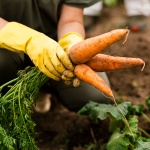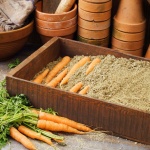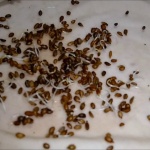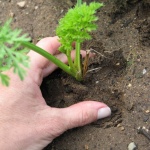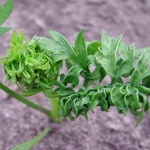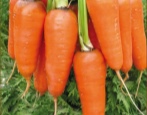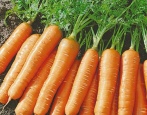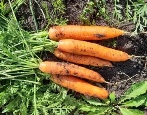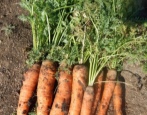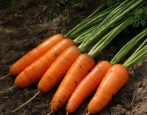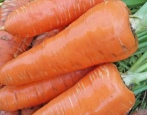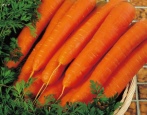
- Appointment: for fresh consumption, for canning, for freezing, for bundled products, for making juice
- Leaf rosette shape: sprawling
- Leaves: bright green
- Weight, g: 150-200
- The form : tapered, tip and head rounded
- Taste qualities: good ones
- Ripening terms: mid-early
- Growing regions: any
- Length, cm: 10-15
- Hangers: flat
Shantane is a carrot variety known to gardeners for over 70 years. The variety has remained very popular for so many years. What is its mystery, consider the example of one of the varieties - Shantane 2461.
Description of the variety
This variety is allowed to grow in any region of Russia, therefore, it is a rather unpretentious plant. Variety Shantane 2461 is distinguished by good marketability and keeping quality for more than 8 months, which means that it is suitable for storage even in winter. But this is not the last advantage of the species: carrots give a high yield, are not prone to flowering in the first year, they tolerate heavy soils well, and have a strong immunity.
It is worth mentioning the disadvantages of the variety. Firstly, for long-term storage of root crops, certain conditions must be observed, and secondly, it is not recommended to exceed the harvest time, otherwise it will provoke a deterioration in the taste of root crops.
Characteristics of the appearance of the plant and root crops
The rosette is spreading, has bright green leaves; Root crops develop in the shape of a cone with a rounded head, their weight is about 150-200 g, length is 10-15 cm, the skin and core are orange.
Purpose and taste of tubers
This carrot can be eaten fresh, especially since it has an almost invisible core. The consistency of the vegetable is dense, juicy, and has a sweet taste. Perfect for canning, frying, adding to salad, making carrot juice, it tolerates freezing well.
Maturation
Shantane 2461 is a medium-early ripening variety.
Yield
This is a high-yielding variety that, on average, is ready to please the gardener with a harvest of 4-9 kg of vegetables per square meter.
Growing and care
Sowing is carried out in May. Any type of soil is suitable for planting - this is a picky variety. However, the vegetable will feel more comfortable in a sunny area or in partial shade. The plant does not need abundant watering, since the tuber grows deep into the ground, it is enough to irrigate the garden as the top layer dries. Every day you need to moisten the ground only before the shoots appear. When the seedlings hatch, watering should be stopped for at least a week so that the roots go deeper into the ground.
In the period July-August, it is enough to water the garden every 7-10 days, but it is important to loosen the soil after each irrigation. Moistening must be stopped a couple of weeks before harvesting, so as not to provoke cracking of the root crops.
This variety responds well to feeding. It is allowed to use both natural and mineral formulations as additional food. In the fall, at the stage of digging the ridge, it is recommended to add humus or compost. When planting in poor soil, nitroammophos can be added, fertile lands do not need fertilization. Summer residents recommend not to abuse nitrogen compounds, as they worsen the keeping quality of root crops. During the growing season, mixtures containing nitrogen, phosphorus and potassium are relevant.
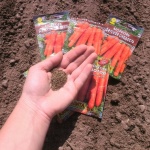
Carrots are one of the most unpretentious crops in terms of growing conditions; they can endure a short drought and a short cold snap. However, to get tasty and large root crops, you should adhere to the basic rules for planting carrots.
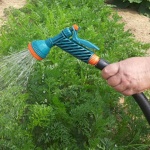
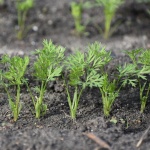
Disease and pest resistance
This variety is highly immune to insects and diseases, but preventive measures should not be ignored. So, observe a competent crop rotation, do not plant seeds close to each other, carefully free the ridge from other plants before planting, weed the weeds well.
If the vegetable nevertheless turned out to be affected by phomaosis, then all the plants will have to be destroyed - this ailment cannot be treated, but to prevent it, add potassium-phosphorus compounds before sowing. Sometimes carrots are affected by white rot: to get rid of it, treat the plants with preparations containing copper.
The most common insect for this culture is the carrot fly: sprinkle the ground with a mixture of naphthalene and sand, and then this pest will not be able to leave eggs here. If the carrot is attacked by a carrot flask, then mechanically remove its eggs, and then treat the plantings with a tobacco solution. Also, in order to avoid damage by this individual, do not plant the vegetable next to conifers.

Carrots grow in almost any garden. There is an opinion that this culture is very resistant to all kinds of diseases and pests, but this is not the case. Without proper care, carrots become susceptible to all kinds of infections and are affected by harmful insects.
